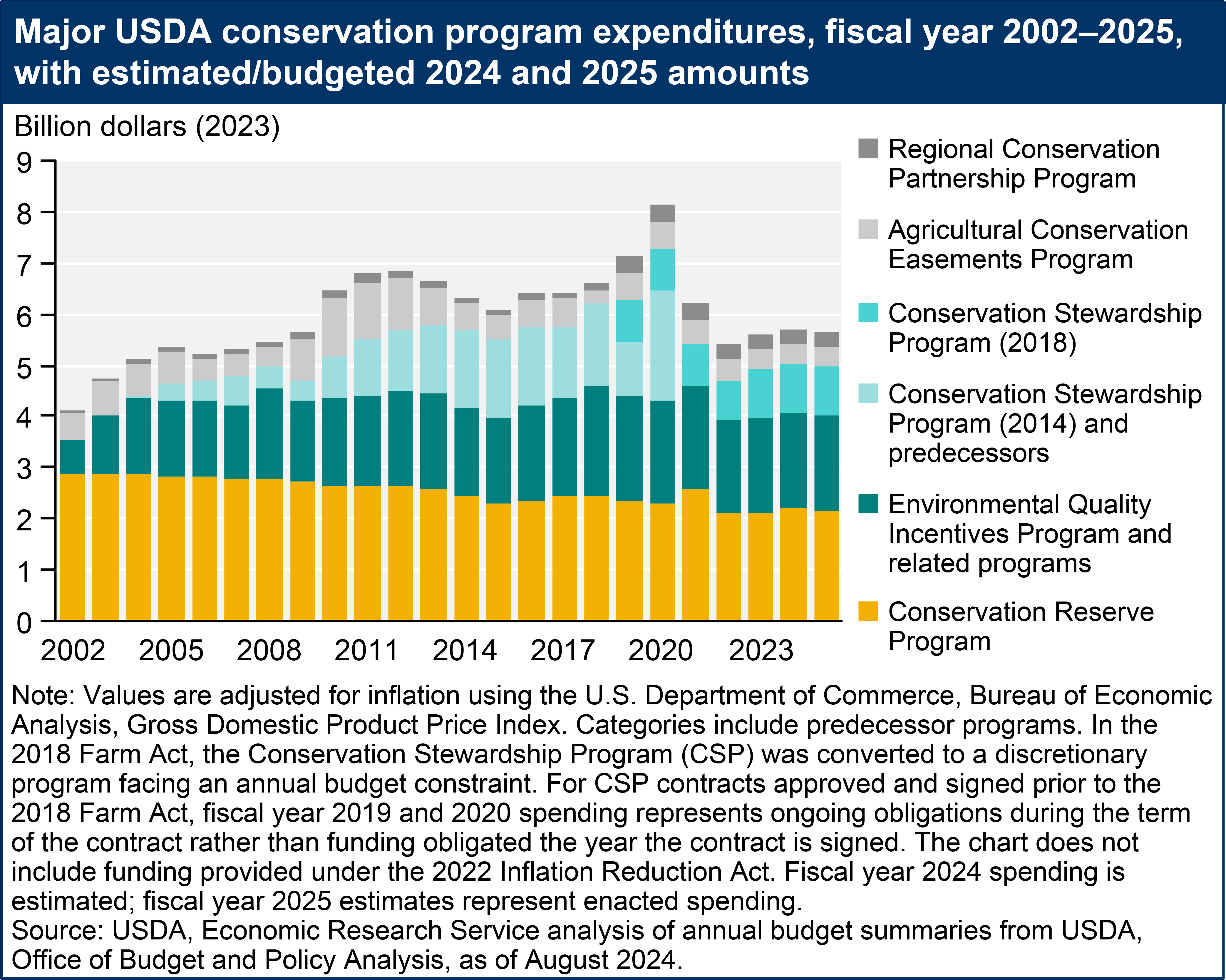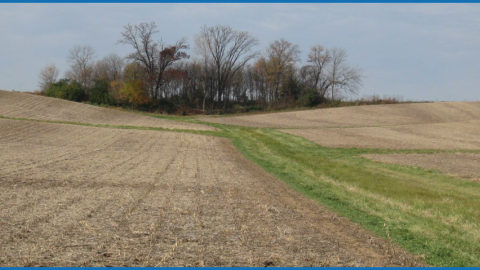USDA's conservation programs are designed to help agricultural producers improve soil health, water quality, air quality, and wildlife habitat. These programs include financial and/or technical assistance to farmers who adopt, install, or maintain conservation practices on land in production—as well as programs that provide easements or contracts to remove land from agricultural production.
A Portfolio of Incentive Programs
- The Conservation Reserve Program (CRP) generally provides 10‒15-year contracts to remove land from agricultural production or engage in specific practices. Most of the land enrolled in the CRP was in crop production prior to CRP enrollment and is now planted to an approved conservation cover, such a mixture of grasses or trees. Many regionally-targeted initiatives within CRP fund high-priority, partial-field practices, such as filter strips and grass waterways. As of June 2024, nearly 9 million acres of grassland are enrolled in CRP, in contracts under which landowners agree to keep the land in grazing use, rather than converting the land to crop production or any other use.
- The Agricultural Conservation Easement Program (ACEP) provides long term or permanent easements for preservation of wetlands and the protection of agricultural land from commercial or residential development. ACEP works through partnerships with Tribes, State and local governments, and non-governmental organizations.
- The Environmental Quality Incentives Program (EQIP) provides financial assistance to farmers who adopt or install conservation practices on land in agricultural production. Common practices include nutrient management, conservation tillage, cover crops, field-edge filter strips, irrigation water management, livestock watering facilities, and fencing.
- The Conservation Stewardship Program (CSP) supports ongoing and new conservation efforts for producers addressing natural resource concerns on working agricultural and forest lands. CSP contracts are for 5 years, and payments go toward maintaining the existing level of conservation and toward implementing additional conservation activities. The 2018 Farm Act also established the CSP Grassland Conservation Initiative, a program that allows eligible producers to receive an annual payment over a 5-year contract for base acres that have been in grass or grasslands over the previous 9-year period, rather than planted with commodity crops.
- The Regional Conservation Partnership Program (RCPP) provides assistance to partners to solve problems on a regional or watershed scale. RCPP can fund a wide range of activities, including land retirement, easements, partial-field practices (e.g., filter strips), and conservation practices on working land (e.g., cover crops).
- Through Conservation Technical Assistance (CTA), USDA provides ongoing technical assistance to agricultural producers who seek to improve the environmental performance of their farms.
For more information about USDA conservation programs and adoption of conservation practices, see the USDA Economic Research Service reports:
- Cover Practice Definitions and Incentives in the Conservation Reserve Program (EIB-233, February 2022) and
- Cover Crop Trends, Programs, and Practices in the United States (EIB-222, February 2021).
For more information about what happens to land enrolled in or rejected from the CRP, consider the USDA, ERS report:
- Land Use of Rejected, Enrolled, and Expiring Fields in the Conservation Reserve Program (EIB-276, August 2024).
For more information about what happens to land in the Conservation Reserve Program when CRP contracts expire, consider the USDA, ERS report:
- The Fate of Land in Expiring Conservation Reserve Program Contracts, 2013-16 (EIB- 215, January 2020).
For more information about how farmers use technical assistance to address resource concerns, see the USDA, ERS report
- USDA Conservation Technical Assistance and Within-Field Resource Concerns (EIB-234, May 2022).
Budgeted Conservation Spending was Level in the 2018 Farm Act
USDA, Economic Research Service studies conservation program spending levels and analyzes trends for the different types of conservation assistance programs. The 2002 Farm Act and 2008 Farm Act each increased conservation program spending. By 2011, inflation-adjusted conservation spending increased by more than 70 percent over 1996 levels. The 2014 and 2018 Farm Acts held total budgeted spending largely level at an average of between $6.0 and $6.5 billion per year in 2023 dollars, while also changing several aspects of program rules. Actual spending, shown in the chart, has varied more year to year. Although most conservation programs receive "mandatory" funding, the funding levels are not guaranteed and could be revised in future years.

Download chart image | Chart data
While overall conservation funding is roughly equal to baseline levels for fiscal year 2019‒23, the 2018 Act shifted funding among programs. Because of the Act’s extension through fiscal year 2024, funding remained at fiscal year 2023 levels through fiscal year 2024.
- Conservation Stewardship Program: The CSP acreage enrollment cap was replaced with a funding cap that sets spending limits of $700 million for fiscal year 2019, increasing to $1 billion by fiscal year 2023. Estimated spending for fiscal year 2024 was $922 million.
- Environmental Quality Incentives Program: EQIP funding was increased from $1.75 billion in fiscal year 2019 to $2.025 billion in fiscal year 2023. Estimated spending in fiscal year 2024 was $1.88 billion.
- Conservation Reserve Program: CRP funding over fiscal year 2019‒23 increased slightly, from $2.0 billion in 2019 to $2.4 billion in 2023, which included increased funding for CRP technical assistance and a shift in acreage into the Grasslands CRP subprogram. Approximately 33 percent of CRP lands in 2023 were enrolled in the Grasslands subprogram. Estimated spending in fiscal year 2024 was $2.2 billion.
- Agricultural Conservation Easements Program: Allocated funding increased from $250 million to $450 million annually, with an estimated $416 million spent in 2024.
- Regional Conservation Partnership Program: The 2018 Farm Act made the RCPP a standalone program, and increased funding from $100 million to $300 million annually. Estimated spending in fiscal year 2024 was $283 million.
For more information about how the 2018 Farm Act impacts allocations between different conservation programs, see 2018 Farm Act Retains Conservation Programs But Could Reduce Payments for Land Retirement (Amber Waves, December 2019).
Conservation Policy and Program Design
USDA, Economic Research Service research examines the cost-effectiveness of conservation policies and programs, with an emphasis on identifying conservation program design features that increase environmental gain per program dollar. USDA, ERS also investigates the environmental impact of broader agricultural policies and programs through land use, input use, and conservation practice adoption. Research findings address many issues in program design, including:
- Targeting: In voluntary conservation programs, eligibility requirements, participation incentives, and ranking of program applications can be used to direct payments to fields, practices, or specific resource concerns that are likely to generate large environmental gains relative to cost. USDA, ERS research has explored targeting wetland restoration efforts (see Targeting Investments To Cost Effectively Restore and Protect Wetland Ecosystems: Some Economic Insights (ERR-183, February 2015)), and cost reductions that could be achieved through spatial targeting in addressing specific environmental problems like water quality in the Chesapeake Bay (see An Economic Assessment of Policy Options To Reduce Agricultural Pollutants in the Chesapeake Bay (ERR-166, June 2014)), and the Gulf of Mexico (see Reducing Nutrient Losses From Cropland in the Mississippi/Atchafalaya River Basin: Cost Efficiency and Regional Distribution (ERR-258, September 2018)).
- Additionality: A conservation practice that is adopted by a farmer who receives financial assistance is "additional" only if the practice would not have been adopted without the payment. That is, to satisfy the requirements of "additionality," the payment must be critical to securing adoption—and any associated environmental gain. Payments for practices that would have been adopted even without financial assistance are not additional. USDA, ERS research shows that USDA conservation programs are effective in encouraging conservation practice adoption, although additionality varies across conservation practices (see Additionality in U.S. Agricultural Conservation and Regulatory Offset Programs (ERR-170, July 2014) and Working Lands Conservation Contract Modifications: Patterns in Dropped Practices (ERR-262, March 2019)).
- Contract design: All USDA conservation programs contract with farmers to specify the application of conservation practices and related payments. Most contracted practices are completed as scheduled. Sometimes, though, contracts are modified or entirely terminated, and agreed-on practices are either replaced with other practices or dropped entirely. For more information on what practices are most often dropped and some possible reasons for dropped practices, see The Fate of Land in Expiring Conservation Reserve Program Contracts, 2013-16 (EIB- 215, January 2020). Also see Economic Experiments for Policy Analysis and Program Design: A Guide for Agricultural Decisionmakers (ERR-236, August 2017).



